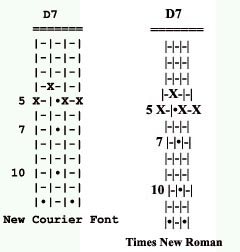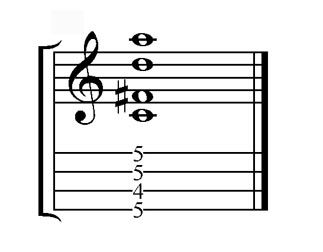« When is a #9 NOT a #9? |
Main
| The virtues of sustain »
 March 25, 2010 | Sharing chords March 25, 2010 | Sharing chords
It happens. Once in a while you find that magic chord in your fingers, and you don't want to lose it in your head. It never hurts to have some way to document it and retrieve it later. You might even want to share it online or email it to a friend.
You can use standard notation; demographically, not that many players are able to read chords immediately, especially more than one note at a time. Some struggle with simple monophonic melodic lines as it is, and in the world of notation you have to include potentially irrelevant definitions like note value and articulation. As strong advocates of standard notation skills, we're not suggesting this is useless information, just in this context we want to be able to show fingerings on the fretboard.
One simple way is to indicate the fret number starting on the G string. A D7 might be 5 4 5 5. This is pretty quick, but takes some getting used to because it's not particularly graphical. On the MandolinCafe.com website, a clever use of ASCII characters yields a pattern very easy to read: MandolinCafe ASCII Chord Library.
Word of caution here--you have to use a font like "courier" or the spacing gets jumbled.

In the publishing world, the preference is to do both standard notation and TAB, and in the course of a song or passage of music, this would be the best way to reach the masses. Of course a good software programs is essential for this:

For your own practical purposes, we suggest using our handy JazzMando fretboard template. Print several of these pages off with your computer and keep them handy, maybe fold one sheet in half or quarter and leave it in your case for when the muse strikes. You don't want to forget that cool chord discovery! Plus, the price is right--FREE!
Print: Jazzmando Chord Template
 As a side note, in the past we used to indicate finger numbers on our fretboard diagrams. This ended a couple summers ago when we noticed in one of his workshops, master clinician and jazz mandolinist, Paul Glasse using a different approach to the same chord. Some will use a combination of barre (double stop) chords, but Paul tended to spread his long thin fingers out and cover the separate chord members with individual fingers. Rather than dictate which finger, which string, we now opt to leave the method of fingering up to the reader, with just a solid circle block. You might want to block your own chords with a black circle, or indicate your own fingering preference. Everybody's fingers are unique in shape, size, and flexibility, however, and you might be surprised at how differently chords are approached by individual professionals. As a side note, in the past we used to indicate finger numbers on our fretboard diagrams. This ended a couple summers ago when we noticed in one of his workshops, master clinician and jazz mandolinist, Paul Glasse using a different approach to the same chord. Some will use a combination of barre (double stop) chords, but Paul tended to spread his long thin fingers out and cover the separate chord members with individual fingers. Rather than dictate which finger, which string, we now opt to leave the method of fingering up to the reader, with just a solid circle block. You might want to block your own chords with a black circle, or indicate your own fingering preference. Everybody's fingers are unique in shape, size, and flexibility, however, and you might be surprised at how differently chords are approached by individual professionals.
Further:
Mandolin Chord Economics
Starting off
Mobility--chord transit
Bridging Chord Melody
Addicted to TAB
Posted by Ted at March 25, 2010 12:40 PM

Disclaimer: In the 'Information Age' of the 21st Century,
any fool with a computer, a modem, and an idea can
become a self-professed 'expert." This site does not
come equipped with 'discernment.'
|



